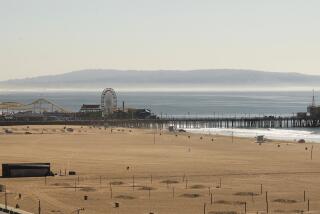Mayor Tries to Sweet-Talk GOP Into Picking S.D.
Seeking to woo the highly sought 1992 Republican Convention, Mayor Maureen O’Connor told top GOP officials Thursday that San Diego is like a “beautiful girl” with a “warm personality” and a “strong spirit” who has only one problem in being courted by her “handsome young suitor: She doesn’t have a dowry.”
O’Connor greeted representatives of the Republican National Committee at a luncheon at the Catamaran Hotel by telling them San Diego was a “rose among the thorns of large urban areas”--a pointed reference to Cleveland, Houston, New Orleans and St. Petersburg, Fla., the city’s competition for hosting the event.
Speaking to several hundred dignitaries in the hotel ballroom, O’Connor described her city as a “gem of sparkling hope” and said, “Other cities have Little Italys or Little Chinatowns, but San Diego is Little America.”
City Councilwoman Judy McCarty echoed the mayor’s words by telling the Republicans, “The analogy is perfect--we may not have a dowry, but we’re very pretty and can promise you a lot of fun.”
The lack of a dowry--or rather, up-front capital--may be the city’s chief negative in what some describe as a race in which San Diego is the clear leader. Business Week magazine reported this week that San Diego is the favorite to capture the event.
Insiders say its chances are aided by White House official Sig Rogich, assistant to the president for public events and initiatives. Rogich, a former Las Vegas ad executive, is reported to be San Diego’s biggest backer and a confidante of President Bush.
But Thursday, officials with the Republican National Committee tried to play down the talk of San Diego being the leader or even a top contender.
“San Diego is no more or no less a favorite than any other city we’re looking at,” said William Harris, chairman of the Site Selection Committee. “It is inaccurate to say that San Diego is the top contender. I know some people have been saying that, but it’s wrong. It’s precipitous to say we’re leaning toward any city.”
In her remarks to the crowd, Jeanie Austin, co-chairman of the Republican National Committee, disputed press accounts that Cleveland and St. Petersburg are out of the running by saying she intends to pass along those rumors to colleague Lee Atwater.
Atwater, the other co-chairman, is recovering from a brain tumor.
“All cities will be equal in going to the drawing room table,” Austin said. “It’s been reported that an insider on the site committee said Cleveland and St. Pete are out. If I find out who said that, I’ll drag that person over to Atwater’s house, and he’ll cut their tongue out.”
In earlier remarks, Austin said the convention site would not be voted on until a meeting of the 165-member national committee in January.
Asked if the GOP is leaning toward San Diego, Austin said, “I don’t know how people can make that assessment.”
She said the Republicans need a pledge of $10 million from any city hosting the event but added that such funds are usually the culmination of private fund-raising. So, O’Connor’s insistence on the lack of a “dowry” should be no problem, much less a strike against the city, Austin said.
GOP official Harris said San Diego is important because it gives the Republicans a “Western option” in a year in which the Democrats have tabbed New York for their convention. He conceded that New York is a controversial choice because of its litany of urban problems and that San Diego might offer a nice contrast.
“It’s the politics of it,” Harris said. “It gives us a strong range of options, and we like to have that as we narrow the sites.”
A factor that may work against San Diego surfaced Thursday in the form of sight lines at the new Convention Center. Technical experts who work for the Site Selection Committee--their job being to evaluate halls and stadia for network-television potential--said the roof of the Convention Center is too low and that numerous poles and pillars pose a view “obstruction” problem.
Mike Miller, the director of news media operations for the committee, said the problem was not unlike watching a baseball game at Fenway Park or Wrigley Field, where a few fans would find themselves perched behind pillars and poles.
“The San Diego Convention Center does have obstructions we’d have to work around,” Miller said. “I’m not saying we couldn’t do it, but it is a problem we’d have to overcome. Part of the difficulty would be putting the seats in so that everyone could see. But, it’s more of a media problem than anything. We have lots of cameras and anchor booths to worry about.”
Miller said San Diego Jack Murphy Stadium, which committee members toured Thursday afternoon, might be used for one or two nights but not for the entire event. The stadium, he said, could easily accommodate an anticipated 15,000 media representatives.
The main problem with having all convention events at the stadium, according to its manager, Bill Wilson, is that the committee needs a “six-week window of time” for set-up, and the stadium--home to both baseball’s Padres and football’s Chargers in August--would be available for only two, at most.
Site Committee Chairman Harris said the Convention Center’s technical shortcomings were not a “major problem,” but when asked if they were a positive, he laughed and said, “No.” He added that the sight-line issue was one of many considerations to be evaluated in San Diego’s “total package.”
Austin said she had been assured that San Diego could provide the needed 20,000 hotel rooms. O’Connor said the city needs the convention, partly because of a glut of hotel space but mainly because it would “jump-start” the new Convention Center, which “badly needs it.”
She said the Convention Center had been a disappointment in failing to attract “big-ticket” gatherings, which it needs, especially in a recessionary time.
For those reasons alone--occupying hotels and hyping the Convention Center--O’Connor disputed those who say the event would not be a boon to tourism. She and other city officials estimate the economic impact to the city at between $50 million and $100 million.
The America’s Cup, scheduled to be completed in San Diego in May, 1992, is expected to bring in as much as $900 million. O’Connor said that, potentially, ’92 could be the most profitable in the city’s history.
The ’92 calendar is already crowded with the sailing regatta, as well as the Baseball All-Star Game and two arts festivals. City Councilman Ron Roberts said Thursday those events are a plus, rather than a minus, in wooing the GOP.
More to Read
Get the L.A. Times Politics newsletter
Deeply reported insights into legislation, politics and policy from Sacramento, Washington and beyond. In your inbox three times per week.
You may occasionally receive promotional content from the Los Angeles Times.










